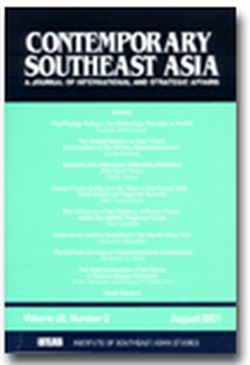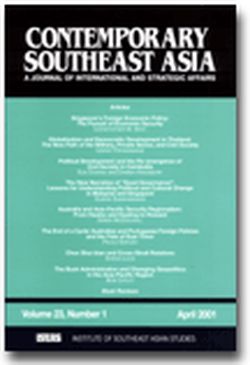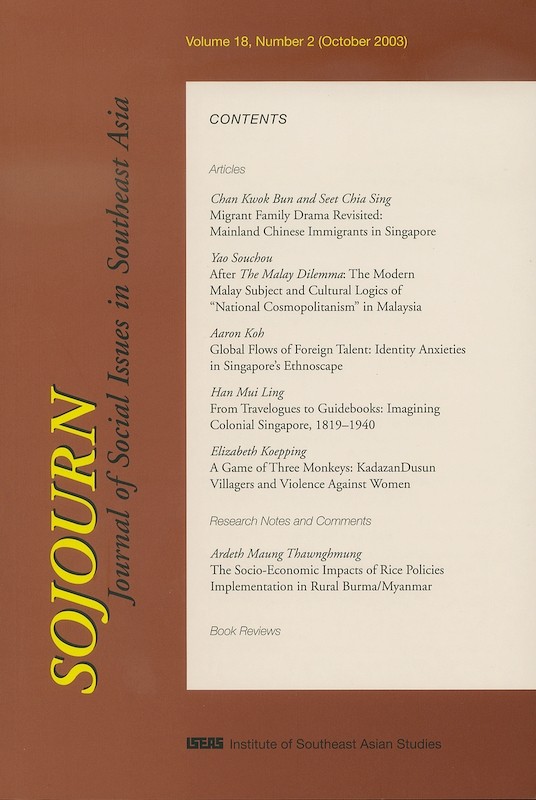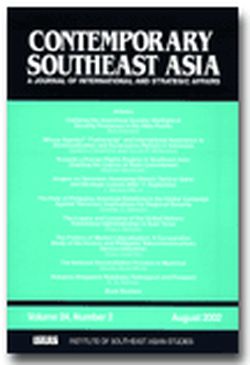Contemporary Southeast Asia: A Journal of International and Strategic Affairs 23/3 (December 2001)
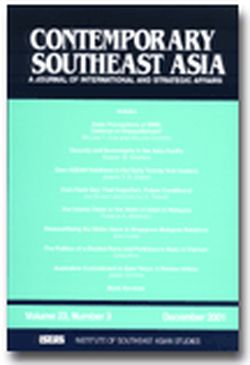
Date of publication:
January 2002
Number of pages:
212
Code:
CS23/3
About the publication
An internationally refereed journal that specializes in the politics, international relations and security-related issues of Southeast Asia and the Asia-Pacific.
Contents
-
Preliminary pages
- ARTICLES
-
Asian Perceptions of BMD: Defence or Disequilibrium?, by William Tow, William Choong, authors see abstractAs geopolitical competition between the United States and China intensifies, East Asian policy-makers are apprehensive about the Bush Administrations plans to develop ballistic missile defence (BMD). Missile defence threatens to undermine other fundamental assumptions about nuclear weapons politics and arms control. This article argues that, if not carefully managed, BMD could undermine Washington's extended deterrence commitments to its regional friends and allies. Initially, a brief summary of developments leading to Asian concerns about missile defense will be offered. How BMD may affect Washington's extended deterrence strategy in the region will be reviewed. Southeast Asia is emphasized here because this sub-region has been largely ignored in previous analyses of BMD's impact on Asia-Pacific stability. The article concludes by offering two policy recommendations regarding the applicability of BMD to ASEANs security environment.
-
Security and Sovereignty in the Asia-Pacific, by Samuel M. Makinda, author see abstractSecurity and state sovereignty need to be understood as two sides of the same coin. Without security, state sovereignty cannot be realized and vice versa. Security and state sovereignty are part of the global understandings, institutions, and rules that are continually being negotiated by global actors, including those in the Asia-Pacific region. While some analysts and policy-makers have claimed that state sovereignty is absolute, indivisible, and inalienable, the transitional societies of Cambodia and East Timor have demonstrated that sovereignty can be shared among several entities, including the United Nations. Moreover, developments in the Asia-Pacific region and elsewhere show that states, international organizations, and other global actors continue to redefine the meanings and understandings of security and sovereignty in their interactions with one another.
-
Sino-ASEAN Relations in the Early Twenty-first Century, by Joseph Cheng, author see abstractThis article examines Sino-ASEAN relations in the early twenty-first century through a study of the role of ASEAN and China in their respective foreign policy frameworks. The interests of the United States and Japan in the Asia-Pacific region and how they have influenced regional co-operation and conflicts will be analysed. Chinas territorial disputes with the ASEAN states, the Taiwan issue, economic co-operation, and the evolution of regional international organizations are among the major issues examined. Sino-American strategic competition has increased ASEANs weight in China's foreign policy. The Chinese leadership is worried about the emergence of a new U.S.-led Asian security alliance, and it appreciates the ASEAN states reluctance to get involved, despite their eagerness to retain a substantial American military presence in the region. Hence, the bargaining power of the ASEAN states has been increased in their dealings with China.
-
Cam Ranh Bay: Past Imperfect, Future Conditional, by Ian Storey, author see abstractThis article reviews the likely future of Cam Ranh Bay in Vietnam in the light of the announcement on 17 October 2001 that Russia will withdraw the last of its military forces in early 2002. Cam Ranh hosts a deep-water port astride the strategic sea lines of communication in the South China Sea. The article provides a historical overview of the development of Cam Ranh Bay during the Soviet period. After Russia's final withdrawal, three countries might seek access: China, the United States, and India. This article assesses the prospects of each country and concludes that India is most likely to be granted access privileges. However, this does not preclude Vietnam from granting access rights to other countries on a case-by-case basis.
-
The Islamic State or the State of Islam in Malaysia, by Patricia A Martinez, author see abstractThe issue of the Islamic state has been at the forefront of Malaysian public discourse, but even more so since the announcement by Prime Minister Mahathir Mohamad in September 2001 that Malaysia was already an Islamic state. The issue has evoked consternation and debate that is not reflected in the mainstream media, and which is symptomatic of the disjuncture between perceptions in public discourse and realities on the ground. This article examines this disjuncture through the symbiosis of the Islamic state issue with its context, the state of Islam in Malaysia. It also provides an analysis of the governments text outlining why its administration qualifies as an Islamic state, against one of the main sources used, which is the Shafii jurist Al-Mawardis Al-ahkam as-sultaniyya.
-
De-securitizing the Water Issue in Singapore-Malaysia Relations, by Joey Long, author see abstractA number of scholars have argued that water may be a determining factor sparking armed conflict between Singapore and Malaysia. They highlight Singapore's dependence on Malaysia for half of its water needs (a supply guaranteed by two compacts signed in 1961 and 1962), and speculate that if Malaysia prematurely abrogates the agreements, water-stressed Singapore will have no qualms about invading its neighbour to secure access to the water stocks. This article examines Singapore's water situation and argues that the prevailing scholarship is too alarmist. It maintains that Singapore has the means to achieve a measure of water self-sufficiency and is not vulnerable to Malaysia's use of the water link as leverage. Consequently, scholars should begin to regard the water issue between Singapore and Malaysia as de-securitized.
-
The Politics of a Divided Party and Parkinsons State in Vietnam, by David Koh Wee Hock, author see abstractThe two most important domestic political events in Vietnam in 2001, the Ninth Party National Congress and the Central Highlands unrest, reveal to observers a divided Vietnamese Communist Party (VCP), and a Parkinsons diseased state. Political struggle among the leadership has bred lack of cohesion within the VCP and the state. It has diverted attention and resources away from the task of good governance. The first part of this article maps the political struggle among the key leaders at the Ninth Congress and examines its major implications. The second part examines the Central Highlands unrest and argues that the fundamental problems associated with it are the lack of a practical land regime as well as the inability of the party-state to control its bureaucracy.
-
Australia's Commitment in East Timor: A Review Article, by James Cotton, author
- BOOK REVIEWS
-
BOOK REVIEW: Politics and the Press in Thailand: Media Machinations. By Duncan McCargo. London and New York: Routledge, 2000. 205pp., by Neil A Englehart, author
-
BOOK REVIEW: Democracy, Development and Decentralization in Provincial Thailand. By Daniel Arghiros. Richmond, Surrey, UK: Curzon, 2001. 308pp., by John Sidel, author
-
BOOK REVIEW: Violence and the State in Suhartos Indonesia. Edited by Benedict R. OG. Anderson. New York: Southeast Asia Program Publications, Cornell University, 2001. 247pp., by Anthony L Smith, author
-
BOOK REVIEW: Burma: Political Economy Under Military Rule. Edited by Robert H. Taylor. London: Hurst & Co., 2001. 168pp., by Michael Aung-Thwin, author
-
BOOK REVIEW: Constructing a Security Community in Southeast Asia: ASEAN and the Problem of Regional Order. By Amitav Acharya. London: Routledge, 2001. 256pp., by Sheldon W Simon, author
-
BOOK REVIEW: The Political and Economic Transition in East Asia: Strong Market, Weakening State. Edited by Xiaoming Huang. Richmond, Surrey, UK: Curzon Press, 2001. 281pp., by Brian Bridges, author

